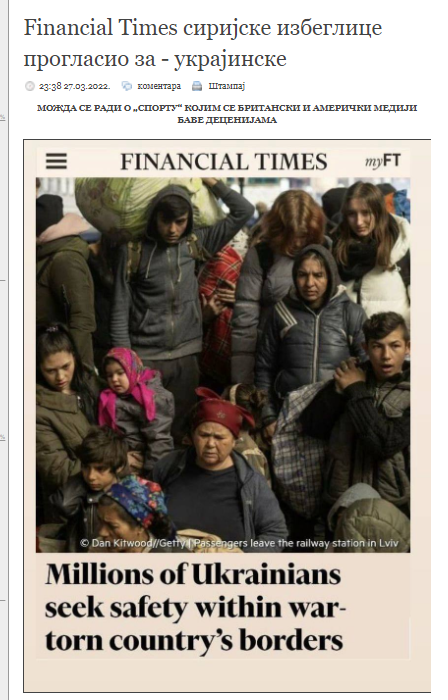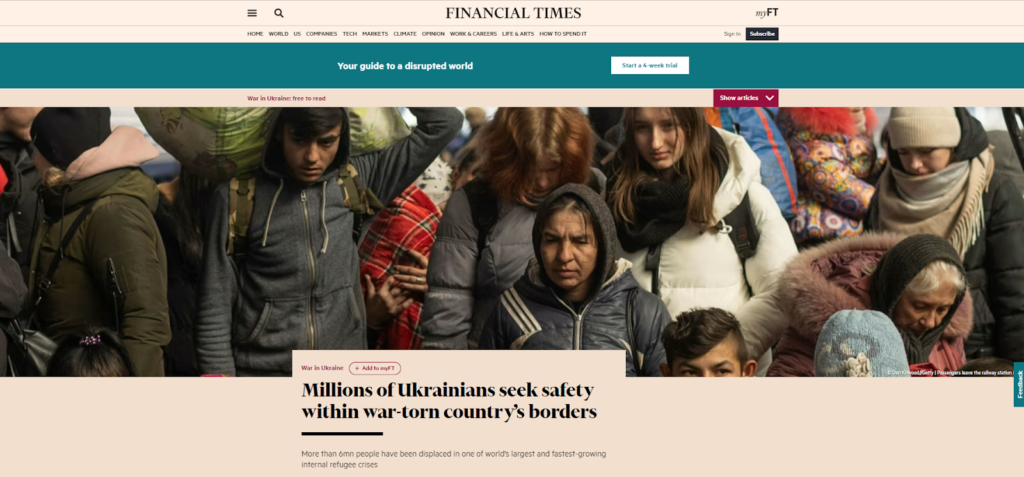Original article (in Bosnian) was published on 09/04/2022
The photo used in the Financial Times article on Ukrainian refugees was incorrectly presented on social networks and in an article on one website as a photo from Syria.
On March 26, 2022, the website Sputnik published an article entitled:
Another fake news from “reputable” Western media
The article states the following:
The editor-in-chief of the news agency “Rusija sevodnja” and the television “RT”, Margarita Simonyan, posted a comment on Telegram regarding the front page of the British “Financial Times”, which allegedly shows refugees from Ukraine.
“Here is what the refugees from Ukraine look like, according to the Financial Times”, she wrote.
On the front page of the British newspaper, next to the photo, there is a headline: “Millions of refugees in search of security in a war-torn country”.
The following day, the website Fakti published an article about the Financial Times illustration, entitled:
The Financial Times declared Syrian refugees – Ukrainian
The article published a screenshot of the headline and photos illustrating the Financial Times article on refugees in Ukraine. The Financial Times article is entitled “Millions of Ukrainians seek security within the borders of a war-torn country”.
LONDON Financial Times illustrated the text about Ukrainian refugees using a photo from Syria.
(…)
It can also happen due to professional “relaxation” and circumstances. But what if it is neither negligence nor coincidence? What if the photo with the Syrian refugees was published on purpose?

A screenshot of the photo and the title of the Financial Times article, with a link to an article on the website Fakti, was published on March 28, 2022, on the Facebook page Vesti Rusija. This post recorded 131 reactions, 31 comments and 22 shares.
On March 27, 2022, Twitter account user Floki posted a screenshot of the headline and photo of the Financial Times, stating that the photo did not show Ukrainians. The following day, the same photo of the Financial Times was published on the Twitter profile of teDkaMila, featuring the following message:
FT to understand the following: 1. White people live in Ukraine. 2. Refugees from the territory of Ukraine mostly go to Russia.
On April 4, 2022, the Facebook page Monte Monte published a screenshot of the headline of a Financial Times article, claiming that the photo of Ukrainian refugees was taken in Syria.
This is what refugees from Ukraine look like according to the Financial Times. The photo is from Syria.
What are the facts?
FakeNews Tragac, our partner fact-checking website from Serbia, wrote about the claims that there are no Ukrainians in the illustration in the Financial Times article. According to their analysis, on March 26, 2022, the Russian Sputnik published an article with the headline claiming that it was “fake news of the western media”. As a source, Sputnik cited a post on Telegram made by the editor of the news agency Russia North and RT television, Margarita Simonyan.
The earliest publication of the claim that the photo featured in the Financial Times article was taken in Syria was found on the Intel Slava Z Telegram channel, where it was published on March 27, 2022. This post has been viewed by over 166 thousand users.
The claim that the Financial Times used a photo of Syrian refugees was also shared in the Macedonian online space. A translation of an article from the website Fakti was published on the Facebook page Pravoslavna Makedonija. The Macedonian Vistinomer analyzed the claims from this publication and assessed them as untrue.
The photo used in an article in the Financial Times, published on March 25, 2022, features authorship information in the lower right corner.

The author is Dan Kitwood, a photographer for the Getty Images agency, and the photo was taken on March 11, 2022, in the Ukrainian Lviv. It was also published on the Getty Images website on the same day.
“LVIV, UKRAINE – MARCH 11: Passengers leave the train station after disembarking from trains from the east on March 11, 2022, in Lviv, Ukraine. More than two million people fled Ukraine after a large-scale Russian attack on the country, and hundreds of thousands of Ukrainians passed through Lviv on their way to Poland. (Photo by Dan Kitwood / Getty Images)
From the analyzed publications, it is clear that the claim about the photograph’s origin is based on the appearance of the people fetaured in it. It is not possible to determine whether the people in the photo from the station in Lviv are Ukrainian citizens, but the claim that the photo was not taken in Ukraine because the people in it do not have the skin color that the authors “expect” from Ukrainians, is racist.
We consider the claim suggesting that the photo in the article of the Financial Times was made in Syria, published in the article of the website Fakti, to be fake news. We assess other publications of this claim as the distribution of fake news.
We assess the claim that Ukrainians are not in the photo as unverified.

